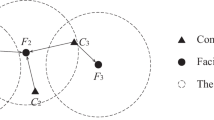Abstract
This paper suggests and compares three median-type location models to determine how to optimally relocate existing emergency medical stations. It also describes a detailed computer simulation model used to evaluate the locations proposed by each model in terms of several indicators of system performance. The simulation model was calibrated using real data from a health care provider in the Slovak Republic. The results of the computer simulation experiments suggest that the simple p-median model can significantly improve the accessibility of urgent health care to patients.





Similar content being viewed by others
References
Aboueljinane L, Sahin E, Jemai Z (2013) A review on simulation models applied to emergency medical service operations. Comput Ind Eng 66:734–750
Ahmadi-Javid A, Seyedi P, Syam SS (2017) A survey of healthcare facility location. Comput Oper Res 79:223–263
Aringhieri R, Carello G, Morale D (2007) Ambulance location through optimization and simulation: the case of Milano urban area. In Proceedings of the XXXVIII annual conference of the Italian operations society-optimization and decisions sciences. Crema: Università degli Studi di Milano, Polo didattico e di ricerca di Crema, pp 1–29
Avella P, Boccia M, Salerno S, Vasilyev I (2012) An aggregation heuristic for large scale p-median problem. Comput Oper Res 39:1625–1632
Bahelka M (2008) Analysis of the emergency medical system after reform (Analýza systému záchrannej zdravotnej služby po reforme) [in Slovak] [online]. Health Policy Institute, Bratislava. http://www.hpi.sk/hpi/sk/view/3795/analyza-systemu-zachrannej-zdravotnej-sluzby-po-reforme.html. Accessed 3 March 2014
Czimmermann P (2016) Location problems in transportation networks. Commun Sci Lett Univ Zilina 18(3):50–53
Erkut E, Ingolfsson A, Erdogan G (2008) Ambulance location for maximum survival. Naval Res Logist 55(1):42–58
Felder S, Brinkmann H (2002) Spatial allocation of emergency medical services: minimising the death rate or providing equal access? Reg Sci Urban Econ 32:27–45
Grigoryev I (2014) AnyLogic 7 in three days: a quick course in simulation modeling [online]. http://www.anylogic.com/free-simulation-book-and-modeling-tutorials. Accessed 2 Nov 2015
Ingolfsson A, Budge S, Erkut E (2008) Optimal ambulance location with random delays and travel times. Health Care Manag Sci 11:262–274
Janáček J, Kvet M (2014) Lexicographic optimal public service system design. In Proceedings of the 32nd international conference mathematical methods in economics. Palacký University, Olomouc, pp 366–371
Janáček J, Kvet M (2016) Sequential approximate approach to the p-median problem. Comput Ind Eng 94:83–92
Jánošíková Ľ, Jankovič P, Kvet M (2017) Improving emergency system using simulation and optimization. In: SOR ´17: Proceedings of the 14th international symposium on operational research in Slovenia. Slovenian Society Informatika-Section for Operational Research, Ljubljana, pp 269–274
Karaš J et al (2017) Proposal of changes in the concept of EMS and TMS (Návrh zmien v koncepcii ZZS a DZS) [in Slovak]. Sapfo, Cassonic, Košice
Krafft T et al (2006) Health monitoring and benchmarking of European EMS systems: components, indicators, recommendations. Project report to Grant Agreement No. SPC.2002299 under the European Community Health Monitoring Programme 1997-2002. Köln: European Emergency Data (EED) Project
Kvet M (2015) Exact and heuristic radial approach to fair public service system design. In: Proceedings of the international conference on information and digital technologies 2015. IEEE, Žilina, pp 185-194
Kvet M, Janáček J (2017) Composed min-max and min-sum radial approach to the emergency system design. In: Operations research proceedings 2015: selected papers of the international conference of the German, Austrian and Swiss operations research society. Springer, Berlin, pp 41–47
Maleki M, Majlesinasab N, Sepehri MM (2014) Two new models for redeployment of ambulances. Comput Ind Eng 78:271–284
Marek J, Slováková J, Hanousek J (2015) Number of EMS interventions (Počet výjezdů IZS) [in Czech]. Forum Stat Slov XI(4):113–119
Ogryczak W, Śliwiński T (2006) On direct methods for lexicographic min-max optimization. In: Gavrilova M et al (eds) International conference on computational science and its applications—ICCSA 2006. Lecture notes in computer science, vol 3982. Springer, Berlin, pp 802–811
Rajagopalan HK, Saydam C, Xiao J (2008) A multiperiod set covering location model for dynamic redeployment of ambulances. Comput Oper Res 35(3):814–826
ReVelle C, Williams JC (2004) Reserve Design and Facility Sitting. In: Drezner Z, Hamacher HW (eds) Facility location: applications and theory. Springer, Berlin, pp 307–328
Sasaki S, Comber AJ, Suzuki H, Brunsdon C (2010) Using genetic algorithms to optimise current and future health planning-the example of ambulance location. Int J Health Geogr 9:4
Schmid V, Doerner KF (2010) Ambulance location and relocation problems with time-dependent travel times. Eur J Oper Res 207:1293–1303
Schneeberger K, Doerner KF, Kurz A, Schilde M (2016) Ambulance location and relocation models in a crisis. CEJOR 24:1–27
Silva PMS, Pinto LR (2010) Emergency medical systems analysis by simulation and optimization. In Proceedings of the 2010 winter simulation conference. IEEE, Baltimore, pp 2422–2432
Sorensen P, Church R (2010) Integrating expected coverage and local reliability for emergency medical service location problems. Soc Econ Plan Sci 44:8–18
Uyeno DH, Seeberg C (1984) A practical methodology for ambulance location. Simulation 43(2):79–87
Zaffar MA, Rajagopalan HK, Saydam C, Mayorga M, Sharer E (2016) Coverage, survivability or response time: a comparative study of performance statistics used in ambulance location models via simulation-optimization. Oper Res Health Care 11:1–12
Acknowledgements
This research was supported by the Slovak Research and Development Agency under the project APVV-15-0179 “Reliability of emergency systems on infrastructure with uncertain functionality of critical elements” and by the Scientific Grant Agency of the Ministry of Education of the Slovak Republic and the Slovak Academy of Sciences under the Project VEGA 1/0342/18 “Optimal dimensioning of service systems”.
Author information
Authors and Affiliations
Corresponding author
Additional information
Publisher’s Note
Springer Nature remains neutral with regard to jurisdictional claims in published maps and institutional affiliations.
Rights and permissions
About this article
Cite this article
Jánošíková, Ľ., Kvet, M., Jankovič, P. et al. An optimization and simulation approach to emergency stations relocation. Cent Eur J Oper Res 27, 737–758 (2019). https://doi.org/10.1007/s10100-019-00612-5
Published:
Issue Date:
DOI: https://doi.org/10.1007/s10100-019-00612-5




